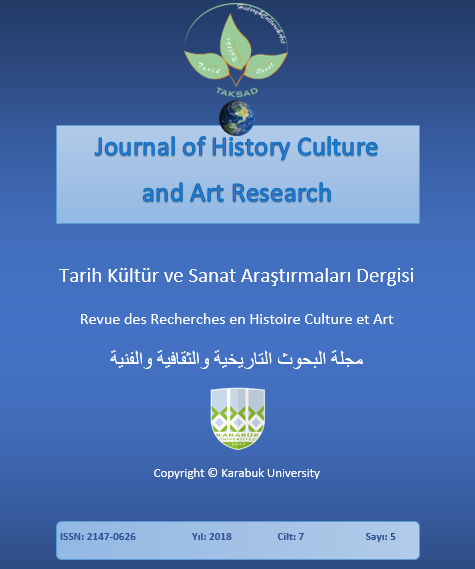The Ancient World-View and Cosmologic Perception of the Arctic Peoples in the Physical Picture of the World
DOI:
https://doi.org/10.7596/taksad.v7i5.1905Keywords:
Myth, Epic, Ancient world-view, Cosmologic perception, Motive, Narrative, Physics, Law.Abstract
The article focuses on the interdisciplinary study of the cosmologic views among the Arctic peoples on the material of oral works – olonkho, nimkan, nimngakan, olongko. An attempt is made at integrating the humanities and sciences with the priority on the convergence. Following the necessity to form a new world-view guideline, the synthesis of the empirical methods and meta-scientific knowledge are considered the starting point in developing the new values of the systemic thinking. The suggested approach shows practical steps towards expansion and deepening of the basics of scientific rationality in humanities (for the highest result of scientific knowledge is considered to be the perception of the universal and objective natural laws in subjects and phenomena in their life process) on the one hand, and humanization and humanitarization of sciences, which provide an important moral category on the other hand. The authors of the study use the methods widely used in folklore study, as well as the less-frequently used modern approaches – synergetics, hermeneutics, and the systemic method. Ancient samples of the Arctic peoples’ epic heritage is brought forward to the inter-disciplinary crossing point, where integration of methodologies allows to remove the dividing line between the rational, irrational, and transcendental categories of human mind, which are directly connected to the problem of studying the very phenomenon of storytelling – a complicated and multi-lateral object of study. Human integrity, formulated by M.S. Kagan as that of “the measure of all things”, serves as the uniting basic fundament of analyzing science and culture. Under the given work such basis serves as an approach to the epic work as the product of storyteller’s work. Comparative analysis revealed a certain semantic and structural unity between the cosmologic perception in the Arctic peoples’ ancient world-view and the modern physical picture of the world. This leads to understanding the strong cognitive unity of the world-formation, which is directly linked to the concept of humanism. The work approbates the methodology of comparison and extrapolation of the different knowledge forms during which a kind of “writing-in” of the old mythological world-views into the fundamental natural laws occurs.
References
Alexeev, N. A. (2008). Ethnography and folklore of the peoples of Siberia. Novosibirsk: Nauka.
Burnashev, N. P. (1993). Kyys Debiliye: Yakut heroic epic. Novosibirsk: Nauka.
Chanyshev, A. N. (1970). Aegeian proto-philosophy. Moscow: Moscow University Publishing House.
Chistov, K. V. (1972). Folkloric words by G. M. Vasilevich. Issues of language and folklore of the Northern peoples. Yakutsk: Institute of Language, literature, and history, 183-238.
Efremov, P. E. (2000). Folklore of Dolgans. Novosibirsk: SB RAS Institute of Archeology and Ethnography Publishing House.
Emelyanov, N. V. (1983). Storylines of the early types of the Yakut olonkho. Moscow: Nauka.
Gogolev, A. I. (2005). Folklore of the Paleo-Asiatic peoples. Proceedings and Reports from the International research conference (November 26-30, 2003).
Govorov, D. M. (2010). The Undefeatable Myuldju Byegye. Olonkho. Translated by E. S. Sidorov. In 2 books. Book 2. Yakutsk: Bichik.
Heizenberg, W. (1990). Physics and Philosophy. Part and the Whole. Moscow: Nauka.
Kapra, F. (1997). Dao of Physics. Retrieved October 1, 2018 from URL: http://lib.ru/KAPRA/daofiz.txt
Karatayev, V. O. (1996). Yakut heroic epic “Er Sogotokh the Mighty”. Novosibirsk: Nauka.
Karatayev, V. O. (2017). Ogo Tulaayakh warrior. Olonkho. Yakutsk: Alaas.
Kaznacheyev, V. P. (1995). Problems of living matter and intellect: studies to theory and practice of the 3rd millenium medicine. Herald of N. A. Kozyrev International Institute of Space Anthropoecology, 2, 7-24.
Keptuke, G. & Robbek V. (2002). Tungus archaic epic (Evenk and Even heroic narrations). Yakutsk: SB RAS Institute of the Problems of the small-numbered peoples of the North Publishing House.
Khudyakov, I. A. (1969). Brief description of the Verkhoyansky district. Leningrad: Nauka.
Lebedeva, Zh. K. (1982). Epic monuments of the peoples of the Far North. Novosibirsk: Nauka
Myreeva, A. N. (1990). Evenki heroic narrations. Novosibirsk: Nauka.
Oyunsky, P. A. (1975). Nyurgun Bootur, the Swift: Olonkho. Translated by V. Derzhavin. Yakutsk: YKI (Yakutsk Publishing House).
Popova, A. S. (1996). Synopsis of the thesis in Candidacy for a degree in Philosophical sciences. Yakutsk.
Popova, U. G. (1981). Evens of the Magadan area. Moscow: Nauka.
Prokopieva, P. E. (2009). Reflection of mythological thinking in the Yukaghir folklore. Novosibirsk: Nauka.
Satanar, M. T. & Illarionov, V. V. (2018). Synthesis of the Fictional and Imagery world-view in Olonkho, and the scientific world-view. World of Science, Culture, and Education, 3 (70), 490-493.
Skorinov, S. N. (2005). Cosmologic beliefs of the Tungus-Manchurians and Nivkhs of the Russian Far East (XIX – early XX centuries). Herald of FEB of RAS, 2, 84-95.
Spiridonov, N. I. (1996). The Oduls (Yukaghirs) of the Kolyma district. Yakutsk: Severoved.
Timofeyev-Teploukhov, I. G. (1985). The Obstinate Kulun Kullustuur. Olonkho. Moscow: Main Editorial Board of Oriental literature.
Varlamova, G. I. & Varlamov, A. N. (2004). Narrations of the Eastern Evenks. Ed. by A. N. Myreeva. Yakutsk: Yakutsk Branch of “SB RAS Publishing House”.
Vinokurova, U. A. & Shilin, K. I. (1995). Life is built by people. Japan – Russian – USA: Eco-synthesis of cultures. Book 1. Ecosophy of Life. Ecosophy of Japan. Moscow: Ochag.
Yadrikhindky, P. P. & Bedjeele (2011). The Maiden-warrior Djyrybyna Djyrylyatta. Yakutsk: Saydam.
Downloads
Published
How to Cite
Issue
Section
License
All papers licensed under Creative Commons 4.0 CC-BY.- Share — copy and redistribute the material in any medium or format
- Adapt — remix, transform, and build upon the material for any purpose, even commercially.
Under the following terms:
Attribution — You must give appropriate credit, provide a link to the license, and indicate if changes were made. You may do so in any reasonable manner, but not in any way that suggests the licensor endorses you or your use.
- No additional restrictions — You may not apply legal terms or technological measures that legally restrict others from doing anything the license permits.







